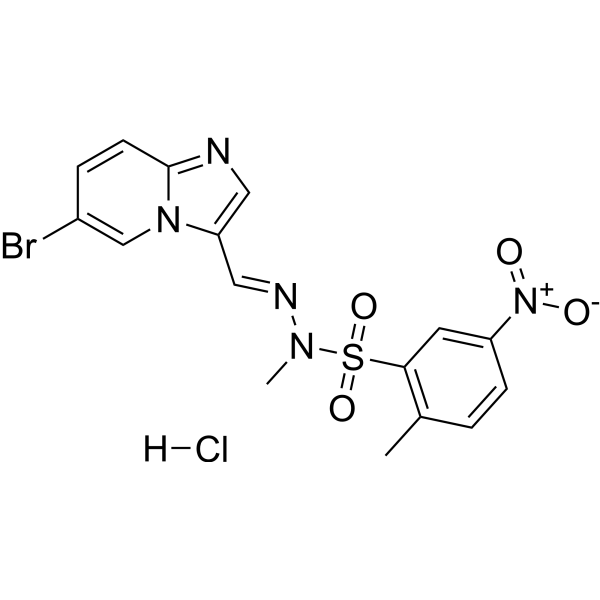Home
Products
PIK-75 HCl



| Product Name | PIK-75 HCl |
| Price: | Inquiry |
| Catalog No.: | CN00411 |
| CAS No.: | 372196-77-5 |
| Molecular Formula: | C16H14BrN5O4S.HCl |
| Molecular Weight: | 488.74 g/mol |
| Purity: | >=98% |
| Type of Compound: | Alkaloids |
| Physical Desc.: | Powder |
| Source: | |
| Solvent: | Chloroform, Dichloromethane, Ethyl Acetate, DMSO, Acetone, etc. |
| SMILES: | Brc1ccc2n(c1)cc(n2)/C=N/N(S(=O)(=O)c1cc(ccc1C)[N+](=O)[O-])C |
| Contact us | |
|---|---|
| First Name: | |
| Last Name: | |
| E-mail: | |
| Question: | |
| Description | PIK-75 is a DNA-PK and PI3K inhibitor, which inhibits DNA-PK, p110α and p110γ with IC50s of 2, 5.8 and 76 nM, respectively. PIK-75 inhibits p110α >200-fold more potently than p110β (IC50=1.3 μM). |
| Target | DNA-PK:2 nM (IC50) p110α:5.8 nM (IC50) p110γ:76 nM (IC50) p110δ:510 nM (IC50) p110β:1.3 μM (IC50) hsVPS34:2.6 μM (IC50) PI3KC2β:1 μM (IC50) PI3KC2α:10 μM (IC50) mTORC1:1 μM (IC50) mTORC2:10 μM (IC50) ATM:2.3 μM (IC50) ATR:21 μM (IC50) PI4KIIIβ:50 μM (IC50) |
| In Vitro | PIK-75 also inhibits p110δ, PI3KC2β, mTORC1, ATM, hsVPS34, PI3KC2α, mTORC2, ATR and PI4KIIIβ with IC50s of 510 nM, ~1 μM, ~1 μM, 2.3 μM, 2.6 μM, ~10 μM, ~10 μM, 21 μM, ~50 μM, respectively. PIK-75 alone blocks Thr 308 phosphorylation in L6 myotubes and 3T3-L1 adipocytes with IC50 values of 1.2 and 1.3 μM, respectively[1]. PIK-75 is a competitive p110α inhibitor with respect to a substrate, phosphatidylinositol (PI) in contrast to most other PI3K inhibitors, which bind at or near the ATP site. Using sequence analysis and the existing crystal structures of inhibitor complexes with the p110γ and p110δ isoforms, a new region of nonconserved amino acids (region 2) is identified that is postulated to be involved in PIK-75 p110α selectivity. Analysis of region 2, using in vitro mutation of identified nonconserved amino acids to alanine, shows that Ser773 is a critical amino acid involved in PIK-75 binding, with an 8-fold-increase in the IC50 compared with wild-type. Further kinetic experiments are undertaken to determine the effect of PIK-75 on the kinetics of binding of ATP and PI to the p11α S773D mutant. Activity is estimated using a range of PI concentrations at the concentrations of 0, 50, 100 and 200 nM PIK-75. The Km for PI is 11.2 μM compared with 7.0 μM for the wild-type enzyme. The Ki for PIK-75 is estimated to be 146 nM, a 64-fold increase on the value estimated for the wild-type enzyme (2.3 nM)[2]. MIA PaCa-2 and AsPC-1 cells are treated with increasing concentration of PIK-75 for 48 h and the cell viability is determined by MTT assay. PIK-75 inhibits the proliferation of pancreatic cancer cells via apoptotic cell death. Submicromolar concentration of PIK-75 is sufficient to inhibit the proliferation of pancreatic cancer, MIA PaCa-2 and AsPC-1 cells after 48-h treatment. PIK-75 also reduces the colony formation of pancreatic cancer MIA PaCa-2 and AsPC-1 cells[3] |
| In Vivo | PIK-75 enhances the antitumor effect of Gemcitabine in vivo. The effect of PIK-75/Gemcitabine combination is further demonstrated by in vivo mouse xenograft model. Mice bearing tumors of MIA PaCa-2 are administered with Gemcitabine (20 mg/kg), PIK-75 (2 mg/kg), or combination of both drugs. Since PIK-75 is a reversible inhibitor, PIK-75 is administered 5 times per week to ensure maintaining sufficient inhibitory effects. Gemcitabine is administered twice per week. Gemcitabine or PIK-75 reduces the tumor growth to similar degree[3] |
| Cell Assay | MIA PaCa-2 cells are maintained in Dulbecco’s modified Eagle’s medium (DMEM) containing 10% heat-inactivated fetal bovine serum (HI-FBS), 2.5% horse serum (HS) and 100 U/mL Penicillin/Streptomycin. AsPC-1 cells are cultured in RPMI-1640 media supplemented with 20% HI-FBS, 100 U/mL Penicillin/Streptomycin and 1 mM sodium pyruvate. A total of 2,000 human pancreatic cancer cells (MIA PaCa-2 or AsPC-1) per well are plated in 96-well flat-bottom plates and then treated with either Gemcitabine, PIK-75 alone (0.1 μM, 0.3 μM and 1 μM) or in combination of both drugs with indicated concentrations. At the indicated times, 20 μL of 1 mg/mL MTT in PBS is added to each well and further incubated for ~4 h. After centrifugation and removal of the medium, 150 μL of DMSO is added to each well to dissolve the formazan crystals. The absorbance is measured at 562 nm using an ELx808 absorbance microplate reader. Absorbance of untreated cells is designated as 100%, and the relative viable cells are expressed as a percentage of this value[3] |
| Animal Admin | Mice[3] MIA PaCa-2 cells (~1.7×106 cells/mouse) mixed with Matrigel are injected subcutaneously into the flank of male athymic nude (Foxn1nu) mice aged 6-weeks. Gemcitabine (50 mg/mL) is dissolved in PBS and PIK-75 (20 mg/mL) is dissolved in DMSO. Injection solution is made as 10% of Cremophor EL and 3% of poly(ethylene glycol) 400 in sterile water. Before administration of compounds, Gemcitabine is further diluted in PBS and DMSO or PIK-75 is further diluted in the injection solution and sterilized by 0.2 μm filter unit. These diluents are mixed with 1:1 ratio and administered into peritoneal cavity of the mouse. Gemcitabine (20 mg/kg) or Gemcitabine (20 mg/kg)/PIK-75 (2 mg/kg) combination is administered twice per week and vehicle control and PIK-75 (2 mg/kg) are administered 5 times per week. The body weights and tumor sizes are measured 3 times per week. Tumor volumes are calculated. |
| Density | 1.7±0.1 g/cm3 |
| PSA | 121.24000 |
| LogP | 3.84 |
| Storage condition | -20°C |